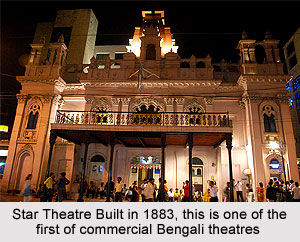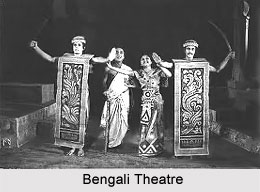 Bengali theatre between the period 1872 and 1912 played an important role in laying the foundation stone for the same. All was achieved against heavy odds. The form was new and alien. Plays had to be written and staged in a hurry. The managers had hardly any time for preparation, besides having to contend with the whims of barely literate owners. The economics could be crippling. If several plays had to be produced within a short time, economic crunch became an issue. And moreover, as Girish Ghosh once commented, the Bengali plays had to be written and staged keeping in mind the sentiments of Bengali people during that time.
Bengali theatre between the period 1872 and 1912 played an important role in laying the foundation stone for the same. All was achieved against heavy odds. The form was new and alien. Plays had to be written and staged in a hurry. The managers had hardly any time for preparation, besides having to contend with the whims of barely literate owners. The economics could be crippling. If several plays had to be produced within a short time, economic crunch became an issue. And moreover, as Girish Ghosh once commented, the Bengali plays had to be written and staged keeping in mind the sentiments of Bengali people during that time.
Girish Ghosh died in the fortieth year of professional Bengali theatre`s life. From small beginnings without a playhouse the theatre had become one of the principal modes of entertainment for middle and upper class Bengalis. The period was also one of explosive growth of Kolkata. The city was a busy and bustling place, where migrants of other tongues came in large numbers. Doubtless they found their own means and areas of amusement. But it was to jatra and the theatre that the Bengali went for entertainment and vicarious experience of romance, humour, prurience, tragedy, religion and patriotism. Bengali theatre had also become a platform for preaching diverse messages and doctrines.
At the first public performance of Nildarpan in the temporary makeshift structure in 1872, sale of tickets grossed Rs. 200/-. Within a decade three permanent playhouses had come up where, if the average gross intake of a performance was less than Rs. 500 the play was usually withdrawn. In 1879 additional performances began to be held on Sundays and Wednesdays besides the regular one on Saturdays. By the late 1890s, average sales had gone up further and so had net earnings. Theatre had become a commercial proposition.
The record of ownership of the different playhouses is a chaotic jumble of investments, huge profits, ruinous losses, interminable litigation, intrigue and scandals. The theatre attracted capital, not always and not wholly for financial returns. It had other, less mercenary, allurements. Whatever the inducement, once money had started flowing the drive towards commercialism became inescapable.
 Acting Styles in Bengali Theatre from 1872-1912
Acting Styles in Bengali Theatre from 1872-1912
In the early formative years, there was huge influence of English theatre in Bengal, but they could not shake the jatra off their systems. The result was that the Bengali theatre became actor-oriented. As a result, the majority of the plays which were written to feed the theatre gave prominence to "heroes" and "villains". They provided ample scope for "star acting". There is no reason to doubt that those who succeeded in getting into the ranks of the "heroes" and "villains" were excellent actors and actresses. It would be difficult to question the histrionic talents of persons like Girish Ghosh, Ardhendu Sekhar Mustafi, Amritalal Basu, Binodini Dasi, Sukumari Dutta, Chunilal Deb, Amarendra Nath Dutta, Surendranath Ghosh, Kshetromoni, Aparesh Chandra Mukhopadhyay, Tara Sundari and others. For one thing, objective critics and knowledgeable observers have not been all that rare. Persons who had no reason to be uncritical or affect condescending attitudes and who knew the theatre of other countries compared favourably the acting they saw with performances elsewhere.
The style of acting they evolved can be summed up as loud and emotional. Whether in tragic or comic roles the emphasis was on large gestures and rhetorical delivery of lines on a crescendo leading to a final outburst. Partly it was the influence of jatra which having gods and goddesses or humans of godly proportions as their dramatis personae had devised a matching, heroic style of its own. Partly also it was the influence of accounts of actors in the English theatre.
The average run of plays was twenty to twenty-five performances. With three or four playhouses and a three-performances-a-week schedule there was a constant demand for new plays. No wonder the vast majority written to meet this insatiable demand were downright bad, the actors doing their ranting best to cover up the flaws.
Plays were lengthy affairs in those days. In the early years when there was no electricity the performances began at candle light and time allotted for plays were not considered sufficient by either the audience or the theatre owners. Girish Ghosh protested on behalf of the playhouses to concerned authorities and prayed for permission to extend the hours.
Costumes in Bengali Theatre from 1872-1912
Costumes in those days were worn for the play, but it did not have much of significance. It was difficult to make out from the costumes whether the actor was a Bengali or a Bihari or a Rajput or a Sikh, a Jat, a Marathi or a South Indian. They all wore the same costume of stockings, short pants (long for elderly characters), army coats covered with spangles and wigs with curling, either a turban or a jewelled Islamic cap as headgear, an imitation pearl necklace, a sword stuck in the belt completed the unvarying costume. The actor would wear the same costume whether as Lord Rama, Lord Krishna or as Mughul Emperor Akbar, Jehangir or the Rajput hero Jaswant Singh. For actresses it was worse as there was one set, for others another. Never mind if she was playing Sita or Noor Jehan or Sanjukta, the heroine would have the same set of costumes.
Stage Designs in Bengali Theatre from 1872-1912
Just like the costumes, stage design or scenography got indifferent notice. The general lay-out of the stage followed the arrangement of the conventional English stage of the nineteenth century. But in the process of copying, it became ludicrous, and as a result there was castle instead of a fortress, a villa instead of gardens, corridors instead of verandahs and drawing-rooms in place of royal courts. Besides being rickety, sets served little purpose either imaginative or functional. The attempt to create "magical effects" excited the stage designers more than being original. Thus there were trap doors and dioramas, of seas turning into forests, of mechanical devices to represent mythical ages in plays staged as early as 1887. Actors would come down from the skies and disappearing in underground, toy trains emitting sparks and smoke would rumble across and there would be, "close combat in chariots".
Reforms made by Amarendra Nath Dutta were not made to move away from this trend. While his innovations gave a new look to the stage they limited rather than expanded the scope for imagination. The derelict sets, the painted drops, the trick effects and the imitation props created theatrical conventions all right, but hardly could create the effects and outcomes that veteran like Girish Ghosh had in mind. The fact is that the Bengali theatre had an array of remarkable actors and actresses, a large number of devoted workers and talents in specialised fields. But it did not have a producer and director in the sense the words are now used. It had to wait till the early 1920s for one in the person in form of Sisir Bhaduri.
The drawbacks however should not take away those achievements of theatre during that era. By the time Girish Ghosh died the theatre had become a habit with the Bengali people. It had endeared itself to a public which steadily swelled and included the high and the low of society. Finally, it grew into a forum for propagation of ideas and instruction, a function it has served throughout its existence.




















